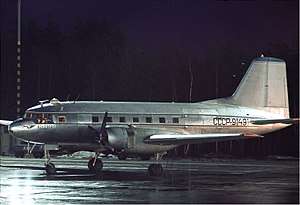Aeroflot Flight 207
Aeroflot Flight 207 was a Soviet domestic passenger flight from Rostov-on-Don Airport to Tbilisi International Airport that crashed on 10 June 1960 in the Tkvarcheli district. The crash involved an Ilyushin Il-14 aircraft operated by Aeroflot. All 24 passengers and 7 crew on board were killed.
 | |
| Accident | |
|---|---|
| Date | 10 June 1960 |
| Summary | Controlled flight into terrain |
| Site | Near Tkvarcheli |
| Aircraft | |
| Aircraft type | Ilyushin Il-14M |
| Operator | Aeroflot |
| Registration | СССР-91571 |
| Flight origin | Rostov-on-Don Airport |
| 1st stopover | Krasnodar International Airport |
| 2nd stopover | Adler/Sochi Airport |
| 3rd stopover | Sukhumi Babushara Airport |
| Last stopover | Kutaisi Airport |
| Destination | Tbilisi International Airport |
| Passengers | 24 |
| Crew | 7 |
| Fatalities | 31 |
| Survivors | 0 |
Aircraft
The Il-14P with a serial number of 7343107 and serial 31-07 would be released by the Tashkent Aviation Plant on 7 August 1957, after which it was sold to the General Directorate of the civil air fleet. The airliner received the tail number USSR-L1571 and was sent to the 77th air transport detachment of the North Caucasus Territorial Directorate of the civil air fleet. In 1959, due to re-registration, the tail number was changed to CCCP-91571. In total, at the time of the crash, the aircraft had total 5423 flight hours.[1]
Crew
The crew of Flight 207 was composed of:[2]
- Pilot-in-Command - Vitaly Yakovlevich Samus
- Flight instructor - Ivan Sergeevich Bozhko
- Co-pilot (Intern) - Viktor Ivanovich Gudkov
- Radio operator - Yelizaveta Nikitichna Sologub
Accident
The crew on Flight 207 were carrying out a flight from Rostov-on-Don to Tbilisi with stopovers in Krasnodar, Sochi, Sukhumi and Kutaisi. At 10:07 Moscow time, the plane, with 24 passengers and 7 crew members on board, took off from Sochi airport. According to the weather forecast, variable stratocumulus cloud with a ceiling of 600–1000 meters and visibility more than 10 kilometers was expected en route. At 10:31 the crew contacted the dispatch center in Sukhumi and reported entering their area of responsibility. Also, a request was made for permission to fly over without landing, since there were no passengers to disembark at Sukhumi. The dispatcher instructed them to climb to and maintain an altitude of 1200 meters. At 10:45 the aircraft reported on the progress of the flight under the Visual Flight Rules and permission was received to make the flight without landing. After that, Flight 207 did not contact the dispatcher in Sukhumi.[2]
At 10:55, the crew tried to contact the dispatcher at the Kutaisi airport. During the call the transmission was unexpectedly interrupted. At the same time, the Il-14, flying in the clouds at an altitude of 1,200 meters, 51 kilometers east of Sukhumi airport and 17 kilometers north of the prescribed route, crashed into the cloud-covered mountain of Recch (altitude 1,436 meters), near Tkvarcheli. After the initial impact with trees, the plane broke in two and after 80 meters, the fuselage fell down a mountain slope. The completely destroyed and burned out plane was found the next day. All the people on board had been killed.[2]
Cause
During the investigation, it was established that Flights 207 and 208 (return) were being performed by the North Caucasus Directorate for the first time, and that the tasking for 77 squadron had been issued 10 days earlier. However, the crew had been assembled in a hurry, and only a day before the flight, on 9 June, there was no flight mechanic or radio operator during training. Although the flight route was considered difficult, the crew had not flown it, and also did not include a navigator. In addition, the crew commander Samus did not have permission to work independently on passenger flights, so the instructor pilot who had returned from vacation on 7 June, that is, 3 days before the flight, was included in the crew. Poorly guided during the flight, as well as not knowing and underestimating the meteorological situation, the crew as a result deviated north of the route. In turn, the Sukhumi dispatchers did not control the flight of Flight 207 on radar and did not carry out continuous radio communication with it. Having flown 100 kilometers within 20 minutes, the crew did not receive a single location message or information on what course it was flying. It was also established that the flights on this route were carried out according to outdated instructions, which in many respects contradicted the existing instructions for the planning of flights (NPP-GA-58).[2]
According to the commission, the causes of the incident were:
- The pilot-in-command did not take the control bearing and did not require the Sukhumi dispatcher to report actual weather and location of the aircraft, instead ceasing radio contact with Sukhumi.
- The flight manager, having information about the weather, did not transmit it to the crew, and also did not ensure that his shift would control the flight.
- The flight controller supervised the flight only on communication from the crew.
- The radio duties were performed by an intern, although they should not have been allowed to work independently; they did not conduct continuous monitoring of the flight.
References
- "Ильюшин Ил-14М CCCP-91571 а/к Аэрофлот - МГА СССР - карточка борта". russianplanes.net. Retrieved 2014-07-30.
- "Катастрофа Ил-14П Северо-Кавказского управления ГВФ близ Ткварчели (борт СССР-91571), 10 июня 1960 года" (in Russian). AirDisaster.ru. Retrieved 2014-07-30.